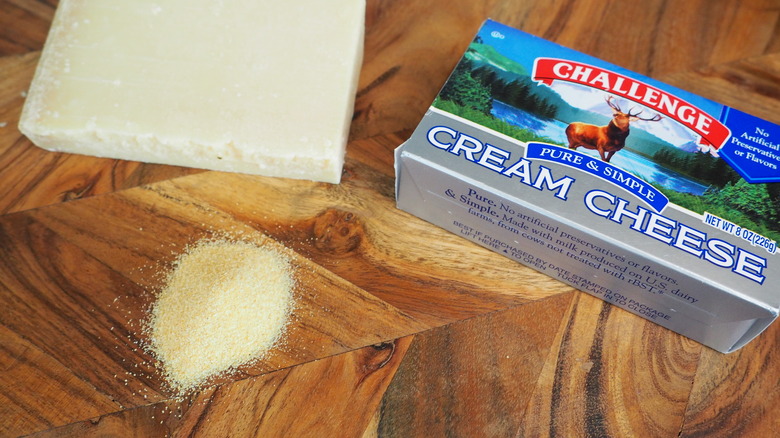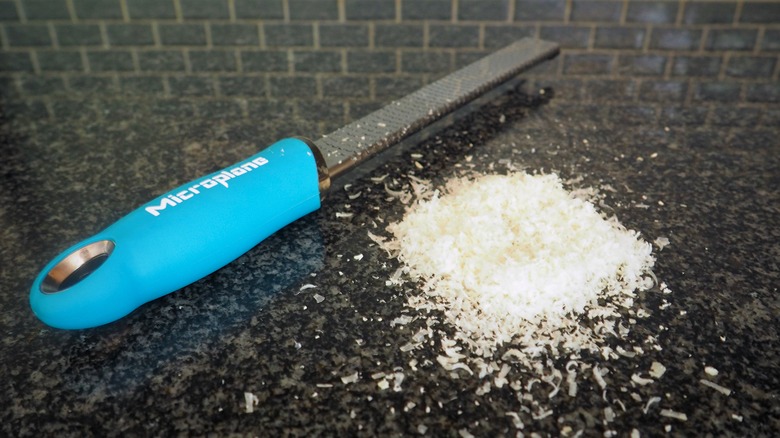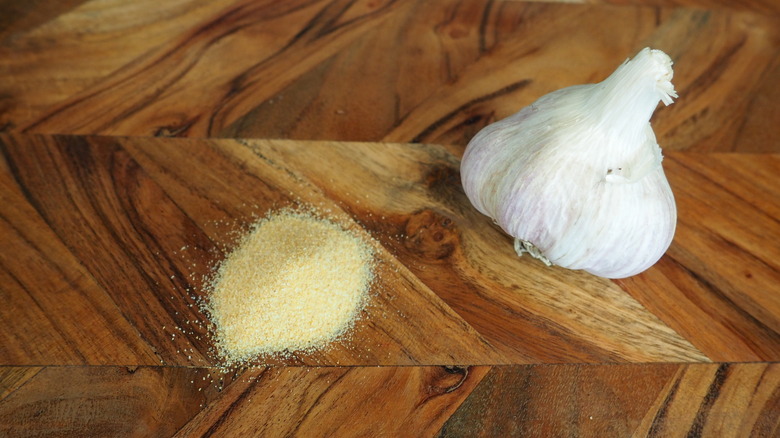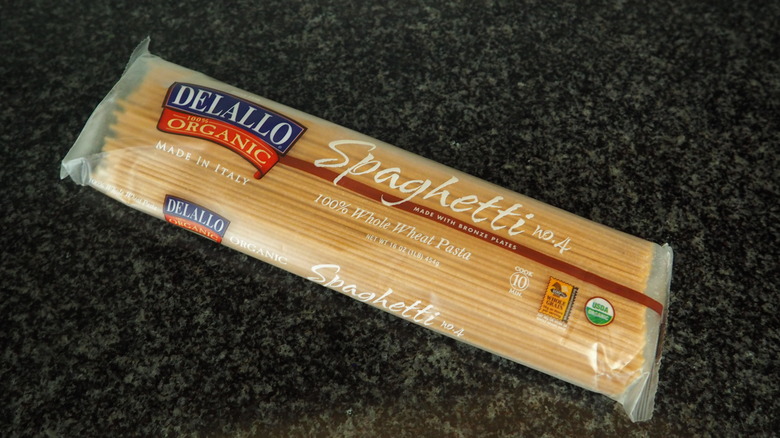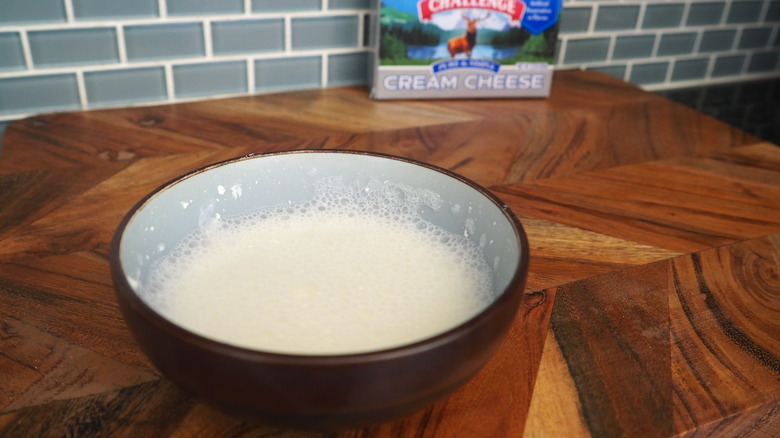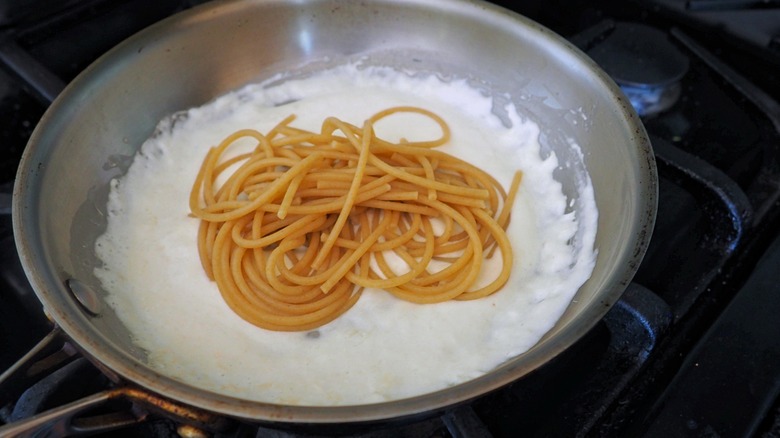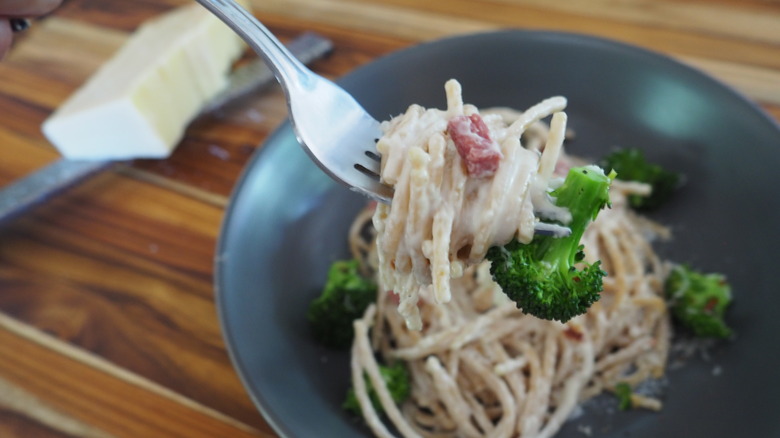3-Ingredient Alfredo Sauce Recipe
What's not to love about Alfredo sauce? It's creamy, cheesy, and rich, and it goes well with just about anything. Toss it with fettuccine pasta to recreate the classic restaurant dish, or use it to smother chicken breasts and bake them in the oven for a dinnertime treat. This sauce goes equally well with vegetables, too, and almost any combination we've tried works, from spinach and kale to more tender veggies like zucchini, tomatoes, and asparagus.
Until recently, we thought that opening up a jar of store-bought sauce was the easiest way to put a weeknight dinner on the table. While Alfredo sauce isn't necessarily complicated to make, it's just time-consuming enough that most of us don't make it from scratch. So we got to thinking: Is there a way to make it quickly and easily, with only a handful of ingredients? Read on to find out if we pulled it off. (Spoiler alert: We were pretty stoked with the results!)
Gather the ingredients for 3-ingredient Alfredo sauce
The traditional recipe for Alfredo sauce involves cooking garlic in butter before adding heavy cream, spices, and Parmigiano Reggiano cheese. Some recipes call for a small amount of flour to thicken the sauce, while others instruct you to reduce the cream until it's nice and thick. We decided to take a shortcut and reduce our ingredients list to three items only: cream cheese, garlic powder, and Parmigiano Reggiano cheese. Okay, there is a fourth ingredient on the list (water to thin out the cream cheese), but that's not an ingredient most of us have to purchase.
Using cream cheese in this recipe works because it's basically a thickened, coagulated version of cream. The Food and Drug Administration (FDA) defines cream cheese as a soft, uncured cheese with a minimum milk fat content of 33 percent. That's pretty similar to heavy cream's 38 percent milk fat. When we thinned the cheese out with water, we found that it essentially become a seasoned version of heavy cream, and the perfect substitute for making Alfredo sauce.
You'll find detailed instructions on how to make enough 3-ingredient Alfredo sauce to coat one pound of pasta, along with ingredient quantities, at the end of this article.
Choose Parmigiano Reggiano for this 3-ingredient Alfredo sauce
When you make a recipe with a limited number of ingredients, you can really taste each component. So we absolutely recommend opting for the highest-quality ingredients you can afford, which includes real Parmigiano Reggiano cheese. Authentic Parmigiano-Reggiano cheese might cost more money, but it's totally worth it.
How will you know you got the right stuff? Parmigiano-Reggiano bears a stamp designating it was made following the Protected Designation of Origin (PDO) rules. These rules state the cheese can only be made in certain areas with high-quality milk, and it rates each wheel based on specific quality standards. Anything labeled Parmesan cheese, on the other hand, doesn't follow any rules. According to Epicurious, this product doesn't even have to be made with fresh milk; it can be made with dried milk or bleached milk.
It's always best to skip the pre-shredded cheese aisle, too. These products can contain cellulose made from wood pulp to keep the cheese from sticking together, causing a gritty texture in your should-be smooth Alfredo sauce.
Should you use garlic or garlic powder to make 3-ingredient Alfredo sauce?
In the interest of using as many common ingredients as possible, we used garlic powder for our 3-ingredient Alfredo sauce. It's easy to stock in the pantry, and the powder is also a little bit easier to use. You don't have to worry about finely mincing whole garlic cloves, so there's no need to dirty a cutting board and knife when making the sauce. And the powder doesn't need to be cooked to remove the raw taste, so the sauce comes together more quickly.
If you don't have garlic powder on hand or you like the flavor of the fresh stuff, feel free to make a swap. In general, a half-teaspoon of garlic powder is a good substitute for one clove of garlic. So, instead of using two teaspoons of garlic powder, chop up four cloves of garlic. We definitely recommend cooking the fresh garlic in about a teaspoon of butter or oil to remove the pungent, raw flavor. Then, proceed with the recipe as directed.
What type of pasta should you use for 3-ingredient Alfredo sauce?
Before we get cooking, let's have a quick discussion about the best pasta for Alfredo sauce. Most of us think of fettuccine with Alfredo, and for a good reason. Food Network confirms that flat, long noodles — like fettuccine, pappardelle, or linguine — work well with creamy sauces because their shape holds up to rich sauces. That said, there's no reason to limit yourself to fettuccine. We used whole-wheat spaghetti in our test batch because that's what we had in the pantry, and this sauce tasted fantastic. Look at tube-shaped noodles like penne or macaroni elbows when using this sauce in a casserole dish, or fun shapes like cavatelli or fusilli to switch things up from time to time.
No matter what noodle shape you choose, you'll want to bring a large pot of salted water to a boil. Then, cook the pasta according to the package directions. When the pasta reaches the desired level of tenderness, drain it into a colander, reserving a quarter-cup of the cooking liquid for later. Don't rinse the pasta under water, which will remove its starches and prevent the sauce from sticking to the noodles.
If the sauce is ready, the noodles can go straight in. Otherwise, set the drained pasta aside until you're ready.
Make the 3-ingredient Alfredo sauce
To make the sauce, we'll start by thinning out the cream cheese, the base of our 3-ingredient Alfredo sauce. Room-temperature cream cheese is easier to work with, but you can totally use cold cream cheese if you forgot to remove it from the fridge ahead of time. Place the cream cheese in a medium bowl and whisk it until it's smooth. Slowly add the cold water a little at a time, whisking constantly to smooth out any lumps that form in the cream cheese. If that sounds like too much work, you could also puree the cream cheese in a food processor, adding the water while the blade is running.
When the cream cheese and water are fully incorporated, heat the mixture in a medium saucepan over medium heat. Add the garlic powder, stirring with a whisk until it's well incorporated. When the cream cheese starts to bubble and has slightly thickened, lower the heat and add the Parmigiano Reggiano cheese a handful at a time. Whisk the first addition into the mixture before adding the next.
Add the cooked pasta to the 3-ingredient Alfredo sauce
The only thing that's left to do is to add the cooked pasta and toss it with the sauce. If the pasta cooled while you were making the sauce, you can heat it back up in the cream cheese mixture. Use low heat and cook until the pasta is warmed through. You can thin out the sauce if it's too thick to coat your noodles by adding a little of that reserved pasta water to the mix, stirring until the sauce reaches the desired consistency.
From here, you can eat the pasta and Alfredo sauce plain, or you can add the meat and vegetables of your choice. We added ham and broccoli because it happens to be what we had in the fridge, but this sauce is a great way to use up any leftovers. Try mixing and matching with shredded chicken or pork, or use thinly-sliced pieces of steak. Ground meat works really well here, too. As far as vegetables go, you can use hearty greens or tender spinach, sliced zucchini, cherry tomatoes, or a mixture. Let your imagination run wild!
How did our 3-ingredient Alfredo sauce taste?
We didn't have any doubts that this recipe would turn out good, but we didn't realize it would be every bit as tasty as store-bought Alfredo sauce. It was rich, garlicky, and cheesy, and it coated the noodles perfectly. The sauce itself didn't have any salt, but it didn't need it. The pasta was perfectly seasoned after being cooked in salted water, and the cream cheese had enough built-in flavor. Our favorite part was that it came together so quickly that we barely would have saved time by opening up a jar of store-bought sauce.
In fact, we liked this 3-ingredient Alfredo sauce so much that we immediately made a second batch. We used it to make stuffed shells and as the base for pizza instead of tomato sauce. That got us thinking: What can't you do with Alfredo sauce, especially one that's this easy to make? Use it as the sauce for casseroles or spread it on French bread to make an amped-up version of garlic bread. It was even delicious when we combined it with tomato sauce for lasagna and tossed with chicken for a fun twist on tacos.
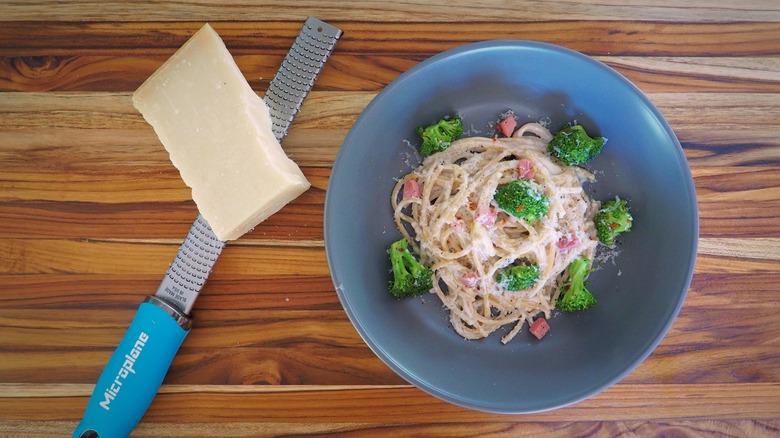
- 1 (8-ounce) package cream cheese, room temperature
- 2 teaspoons garlic powder
- 6 ounces grated Parmigiano Reggiano cheese
- Cook one pound of pasta in boiling, salted water according to the package directions. When the pasta reaches the desired level of doneness, reserve 1/4 cup of the cooking liquid and drain the pasta but do not rinse it under water. Set aside.
- Place the cream cheese in a medium bowl and whisk it until it's smooth. Slowly add the cold water, whisking as you add to smooth out any lumps in the cream cheese. Alternatively, you can place the cream cheese in a food processor and add the water while the blade is running.
- In a medium saucepan or skillet, heat the thinned cream cheese over medium heat. Add the garlic powder, stirring with a wire whisk until smooth.
- When the cream cheese mixture is bubbly and slightly thickened, lower the heat to low. Add the Parmigiano Reggiano cheese a little at a time, whisking to melt the first addition before adding the next. When all the cheese is incorporated, remove the pan from the heat. Add the cooked pasta and toss it in the sauce until it's well coated. If the pasta has cooled, heat the mixture over low heat until the pasta is warmed through. If the sauce is too thick to coat all the noodles, thin out the alfredo sauce with the reserved pasta water.
- Add your cooked meat and vegetable additions (if desired) and serve immediately.
Nutrition
| Calories per Serving | 244 |
| Total Fat | 20.3 g |
| Saturated Fat | 11.9 g |
| Trans Fat | 0.0 g |
| Cholesterol | 60.9 mg |
| Total Carbohydrates | 3.2 g |
| Dietary Fiber | 0.1 g |
| Total Sugars | 1.5 g |
| Sodium | 528.7 mg |
| Protein | 12.5 g |
